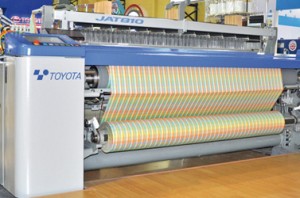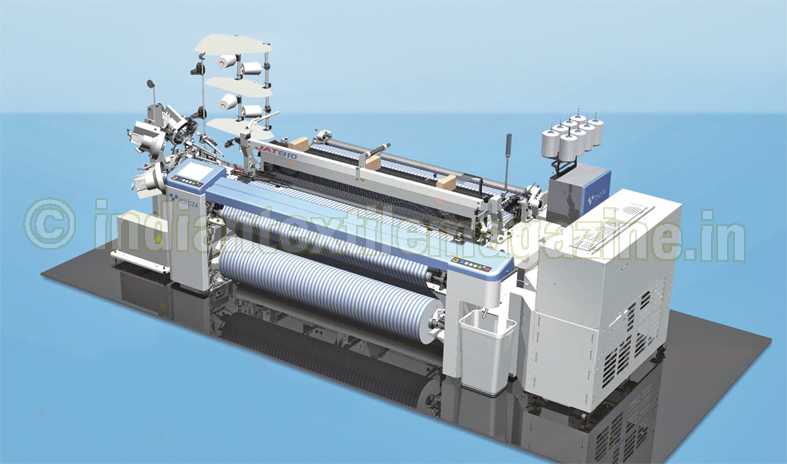Concerted drive for enhancing energy savings and productivity

Toyota Industries Corporation has made the first model change in 10 years to its air jet loom, the main product of its textile machinery business, while commencing production of the new machine, the JAT810, on August 6. This machine is the successor to the JAT710, which was first marketed in 2003 and has claimed the number one share in the worldwide market for 10 consecutive years. The JAT810 has been comprehensively designed for greater energy savings, higher productivity and improved ease of use.
As electricity and labor costs are rising in emerging nations such as China and India, which constitute the main markets for air jet looms, demand for products with greater energy savings and increased productivity is expanding.
In order to meet these market needs, TICO has adopted a new weft insertion system which has produced a 20 per cent reduction in air consumption compared to the previous model. The weave assist system, the “New WAS” incorporating expertise gained by TICO over many years, and a factory management system, “FACT,” that enables centralized management of the entire factory, also contribute to increased productivity. In addition, TICO has developed its own original electronic shedding device, the “E-shed,” which provides high-speed weaving as well as versatility.
As a corporation supporting the clothing aspect of people’s need for food, clothing and shelter in the nearly 90 years since completing the first Toyoda automatic loom, Type G, TICO has been continually striving to develop looms that produce high quality textiles at a low cost, based on the concept of Jidoka (automation with a human touch).
With the JAT810, the company is continuing its contributions to development of the global textile industry, responding to customers’ demands quickly and with meticulous attention to detail through the industry’s leading service network extending around the world.

The main features of the JAT810 are:
First, the 20 per cent reduction in air consumption compared to the previous model, through innovative weft insertion system. With the new sub-nozzle, weft insertion with less air usage is achieved by the optimization of the air stream angle and TICO’s original nozzle aperture configuration.
With TICO’s original reed, “JAT e-REED”, the optimized shape of the reed’s tunnel allows the sub-nozzle to be located closer to the reed, thereby preventing the air stream from scattering. This enables air consumption for the weft insertion to be reduced.
Increased productivity is ensured through factory management. The “New WAS” system which incorporates TICO’s many years of weaving know-how in digital form automatically makes optimal settings, enabling the machine to perform the role of a skilled worker.
Optimal weaving conditions and settings are automatically determined by the “New WAS” simply by selecting the basic conditions (type of yarn, density and pattern) corresponding to a wide variety of textiles. An adjustment support function has been added, which helps reduce defects in quality and enables the user to make quick adjustments to the machine setting.
The factory management system “FACT” can display a wide range of operational parameters and production information for each machine, including air consumption according the actual factory layout, thus achieving enhanced productivity through centralized management of the entire factory.
Development of the TICO original “E-shed” electronic shedding device is noteworthy indeed. The independently-driven shedding technology developed by TICO enables faster weaving of complex fabrics, thus achieving both high-speed and versatility.
With a new function panel, the large 12-inch panel allows large amounts of information to be displayed on a single screen, and the adoption of swipe operation provides easier, more visual operability.
Based on the philosophy of founder Sakichi Toyoda, which reflects his strong commitment to manufacturing, Toyota Industries responds to a broad range of needs with its extensive product line-up, from air-jet looms, for which the company enjoys the top global leadership in unit sales, to spinning frames and roving frames.
The year 2012-13 was a difficult one for the company due to sluggish market conditions that caused a fall in unit sales of air-jet looms to 600 units, or 11 per cent, from the previous fiscal year’s 4,600 units. Net sales, on the other hand, were up ¥1.4 billion, or four per cent, over the previous fiscal year to ¥39.9 billion in conjunction with making Swiss-based Uster Technologies AG, a Toyota Industries subsidiary in February 2012.
In spinning machinery, Toyota Industries and Truetzschler co-developed the TCO 12 comber. Combining Toyota Industries’ weaving machinery technology and know-how accumulated over the years and Truetzschler’s spinning machinery technology and expertise which have earned high acclaim among customers worldwide, the new comber provides improved yarn quality as well as excellent stability during high-speed operation. The company will also accelerate its R&D activities to create innovative weaving and spinning machinery by leveraging Uster’s world-class sensor technology and the information processing technology.